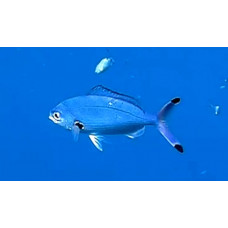Latin name
Caesio lunaris
Other name
Blue fusilier or moon fusilier.
Identification
The body of the Lunar Fusilier is moderately tall, spindle-shaped, somewhat compressed at the sides. Body height is 3.0-4.2 times the standard body length. One postmaxillary protuberance. Mouth small, terminal, retractable. Small conical teeth on both jaws, scopa and palate. Bands of scales on temporal region separated by a narrow scaleless zone. There are 45-53 scales on the lateral line.
Features of fish fins
The dorsal fin has 10 barb rays and 14 (rarely 13 or 15) soft rays. The anal fin has 3 barb rays and 11 (rarely 10) soft rays. The dorsal and anal fins are covered with scales. The pectoral fins have 19-20 soft rays (rarely 18 or 21). The caudal fin is forked. Dorsal and anal fins covered with scales. The barbed portion of the dorsal fin is covered with scales for 3/4 of its height.
Fish colouring
Body bluish, belly slightly paler. Tops of caudal fin blades, axils and upper parts of pectoral fin bases are black. Caudal fin is blue (in juveniles, the caudal fin and part of the caudal peduncle are yellow). Pectoral, pelvic and anal fins white to pale blue. Dorsal fin bluish. In juveniles, the caudal fin and caudal peduncle are yellow. The yellow coloration disappears, probably to avoid being too conspicuous in clear water. However, in the Persian Gulf, where adults fatten in shallow areas with more turbid water, the yellow coloration is retained.
Distribution
Widespread in tropical and subtropical waters of the Indo-Pacific from the east coast of Africa (including the Red Sea and Persian Gulf) to Samoa, southern Japan and the Solomon Islands.
Habitat
Marine pelagic fish. They live near coral reefs or close to them at depths from 0 to 60 m.
Size
Males of this species reach a maximum length of 40.0 cm.
Behavior
Form large aggregations. Juveniles live above coral reefs in association with other species of Caesionidae. Adults move away from the reefs during the day and feed in deeper areas where the water is clear. They return to the reefs only to spend the night. These species do not migrate.
Food and feeding habits
Lunar fusiliers feed on zooplankton in the water column.
Reproduction
Egg-laying, with numerous small pelagic eggs.
Fishing
The species is of minor commercial interest.
Relationship with a person
Harmless.
| Classification | |
| Phylum | Chordata |
| Class | Actinopterygii |
| Squad | Perciformes |
| Family | Caesionidae |
| Genus | Caesio |
| Species | C. lunaris |
| Features | |
| Conservation status | Least Concern |
| Habitat | Pelagic |
| Life span, years | No information |
| Maximum body weight, kg | No information |
| Maximum length, cm | 40 |
| Sailing speed, m/s | No information |
| Threat to people | Edible |
| Way of eating | Planktonophage |
Lunar fusilier
Tags: lunar fusilier



